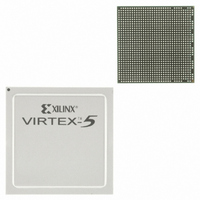XC5VSX50T-3FF1136C Xilinx Inc, XC5VSX50T-3FF1136C Datasheet - Page 27

XC5VSX50T-3FF1136C
Manufacturer Part Number
XC5VSX50T-3FF1136C
Description
IC FPGA VIRTEX-5 50K 1136FBGA
Manufacturer
Xilinx Inc
Series
Virtex™-5 SXTr
Datasheets
1.XC5VLX30-1FFG324C.pdf
(91 pages)
2.XC5VLX30-1FFG324C.pdf
(13 pages)
3.XC5VLX30-1FFG324C.pdf
(385 pages)
Specifications of XC5VSX50T-3FF1136C
Number Of Logic Elements/cells
52224
Number Of Labs/clbs
4080
Total Ram Bits
4866048
Number Of I /o
480
Voltage - Supply
0.95 V ~ 1.05 V
Mounting Type
Surface Mount
Operating Temperature
0°C ~ 85°C
Package / Case
1136-BBGA, FCBGA
For Use With
HW-V5-ML506-UNI-G - EVALUATION PLATFORM VIRTEX-5HW-AFX-FF1136-500-G - BOARD DEV VIRTEX 5 FF1136
Lead Free Status / RoHS Status
Contains lead / RoHS non-compliant
Number Of Gates
-
Available stocks
Company
Part Number
Manufacturer
Quantity
Price
Company:
Part Number:
XC5VSX50T-3FF1136C
Manufacturer:
Xilinx Inc
Quantity:
10 000
- XC5VLX30-1FFG324C PDF datasheet
- XC5VLX30-1FFG324C PDF datasheet #2
- XC5VLX30-1FFG324C PDF datasheet #3
- XC5VLX30T-1FFG665C_PRODUCT_CHANGE PDF datasheet #4
- Current page: 27 of 385
- Download datasheet (14Mb)
Virtex-5 FPGA User Guide
UG190 (v5.3) May 17, 2010
Global Clock Buffers
There are 32 global clock buffers in every Virtex-5 device. Each half of the die (top/bottom)
contains 16 global clock buffers. A global clock input can directly connect from the P-side
of the differential input pin pair to any global clock buffer input in the same half, either top
or bottom, of the device. Each differential global clock pin pair can connect to either a
differential or single-ended clock on the PCB. If using a single-ended clock, then the P-side
of the pin pair must be used because a direct connection only exists on this pin. For pin
naming conventions please refer to the Virtex-5 Family Packaging Specifications. A single-
ended clock must be connected to the positive (P) side of the differential global clock pins.
If a single-ended clock is connected to the P-side of a differential pin pair, then the N-side
can not be used as another single-ended clock pin. However, it can be used as a user I/O.
The 20 global clock pins on Virtex-5 devices can be connected to 20 differential or 20 single-
ended board clocks.
Global clock buffers allow various clock/signal sources to access the global clock trees and
nets. The possible sources for input to the global clock buffers include:
•
•
•
•
The global clock buffers can only be driven by sources in the same half of the die
(top/bottom).
All global clock buffers can drive all clock regions in Virtex-5 devices. The
primary/secondary rules from Virtex-II and Virtex-II Pro FPGAs do not apply. However,
only ten different clocks can be driven in a single clock region. A clock region (20 CLBs) is
a branch of the clock tree consisting of ten CLB rows up and ten CLB rows down. A clock
region only spans halfway across the device.
The clock buffers are designed to be configured as a synchronous or asynchronous glitch-
free 2:1 multiplexer with two clock inputs. Virtex-5 FPGA control pins provide a wide
range of functionality and robust input switching. The following subsections detail the
various configurations, primitives, and use models of the Virtex-5 FPGA clock buffers.
Global clock inputs
Clock Management Tile (CMT) outputs including:
•
•
Other global clock buffer outputs
General interconnect
Digital Clock Managers (DCMs)
Phase-Locked Loops (PLLs)
www.xilinx.com
Global Clocking Resources
27
Related parts for XC5VSX50T-3FF1136C
Image
Part Number
Description
Manufacturer
Datasheet
Request
R

Part Number:
Description:
IC FPGA VIRTEX-5 50K 1136FBGA
Manufacturer:
Xilinx Inc
Datasheet:

Part Number:
Description:
IC FPGA VIRTEX-5 50K 1136FBGA
Manufacturer:
Xilinx Inc
Datasheet:

Part Number:
Description:
FPGA Virtex®-5 Family 52224 Cells 65nm (CMOS) Technology 1V 665-Pin FCBGA
Manufacturer:
Xilinx Inc
Datasheet:

Part Number:
Description:
IC FPGA VIRTEX-5 50K 665-FCBGA
Manufacturer:
Xilinx Inc
Datasheet:

Part Number:
Description:
IC FPGA VIRTEX-5 50K 665FCBGA
Manufacturer:
Xilinx Inc
Datasheet:

Part Number:
Description:
IC FPGA VIRTEX-5 50K 665FCBGA
Manufacturer:
Xilinx Inc
Datasheet:

Part Number:
Description:
IC FPGA VIRTEX-5 50K 1136FBGA
Manufacturer:
Xilinx Inc
Datasheet:

Part Number:
Description:
IC FPGA VIRTEX-5 50K 1136FBGA
Manufacturer:
Xilinx Inc
Datasheet:

Part Number:
Description:
IC FPGA VIRTEX-5 50K 665FCBGA
Manufacturer:
Xilinx Inc
Datasheet:

Part Number:
Description:
IC FPGA VIRTEX-5 50K 1136FBGA
Manufacturer:
Xilinx Inc
Datasheet:

Part Number:
Description:
IC FPGA VIRTEX-5 50K 1136FBGA
Manufacturer:
Xilinx Inc
Datasheet:

Part Number:
Description:
IC FPGA VIRTEX-5 50K 665FCBGA
Manufacturer:
Xilinx Inc
Datasheet:

Part Number:
Description:
IC FPGA VIRTEX-5 50K 665FCBGA
Manufacturer:
Xilinx Inc
Datasheet:

Part Number:
Description:
IC FPGA VIRTEX-5 50K 665FCBGA
Manufacturer:
Xilinx Inc
Datasheet:

Part Number:
Description:
IC FPGA VIRTEX-5 50K 665FCBGA
Manufacturer:
Xilinx Inc
Datasheet:











